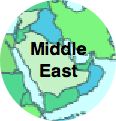Middle East
Regional Summary: Middle East
 Read more about this region in Wikipedia.
Read more about this region in Wikipedia.
Active Countries in the Region Include:
 Israel
Israel
Summary of Activities
In Israel thousands of initiatives dealing with peace education are targeted at pupils from kindergarten through university. In most cases the focus is on Jewish-Arab relations (an “intractable” conflict), but numerous initiatives exist that address conflicts of a different nature, whether those subsisting between the religious and secular publics, veteran Israelis and new immigrants, etc. Some of these initiatives are administered by the Ministry of Education, while others are operated by various non-governmental organizations and institutes (NGOs).
Education for peace and conflict resolution lies within the purview of two separate units within the Education Ministry – a unit responsible for teaching democracy and civics at the cognitive level, and the Psychological Counseling Service, which deals with the emotional-social side of these issues. An estimated 300 NGOs are currently active in this field, whether directly or indirectly. An effort is underway to organize them within a Jewish-Arab coexistence network (www.coexnet.org.il).
It is very difficult to assess the scope of activity represented by the various existing initiatives. The initiatives may be divided into two main types:
A. Jewish-Arab encounter programs: “mixed” and bilingual schools, “twin” schools, joint delegations abroad, summer camps, etc.
B. Study and enrichment programs: programs within the education system that deal with education for coexistence and democracy, for multiculturalism, humanism, mediation, etc. Israeli universities operate teacher training programs based on principles of social justice, as well as programs that focus on research and development.
Research has recently been conducted at the University of Haifa on the topic of peace education. The findings indicate that, despite all efforts, only about 6% of the pupil population is exposed to education of this kind. There is reason to believe that a more precisely-formulated and binding standard regarding peace education would produce more precise findings.
Numerous cooperative endeavors exist between the formal education system and the NGOs. These partnerships generally spring up at the local (school or locality) level; occasionally they are driven by key units within the Ministry. High motivation and initiative on the part of teachers, along with knowledge and budgets provided by involved organizations, are what make efforts of this nature possible. We have no hard data regarding the scope of these activities.
Long-term programs characterized by continuity and tenacity are among the most successful ventures in this area. Of particular note are the bilingual schools where Jewish and Arab pupils study together in mixed classes. The Seeds of Peace program, in which participants spend extended periods of time together in a structured summer-camp format, is also recognized as a success story.
Ministry of Education policy encourages the development and implementation of programs of this kind:
Allocation of 1 study hour per week throughout the education system, from kindergarten through high school, to the subject of life skills.
Encouragement of local initiatives aimed at developing and incorporating relevant programs.
Promotion of contact with bodies external to the schools.
At a minimum, one may say that all Israeli children are exposed in one form or another to some kind of program related to this field. However, only about 6% take part in comprehensive, long-term programs.
Legislative and Policy Initiatives:
Research and development centers exist at all of the universities. There are also several national peace centers, including:The Givat Haviva Peace Center (JACP@givathaviva.org.il) is a major producer of innovative models for peace education. The methods employed by the Center include encounter, dialogue, partnership, study, and research.Neve Shalom (www.nswas.com) – a Jewish-Arab locality. In Neve Shalom there is a mixed Jewish-Arab school, as well as a Pluralistic Spiritual Center that serves as a venue for educational activity for pupils, teachers and others.CRE Resources:
In the Israeli situation, with pupils studying in separate schools (Arab or Jewish, religious or secular), infrequent encounters and classroom activities are not enough.There is a need for legislation or explicit directives, backed by continuous budgeting from within the system, to ensure continuity and adequate depth of study.There is a need for increased knowledge of, and familiarity with, the culture, language and customs of the “other” group. This must also be embodied in a binding regulation, rather than left to the judgment of personnel at the regional or school level.The number of participating schools should be increased. Jordan
Jordan
Summary of Activities
For a summary of CRE activity in this area please review the (now rather dated) OCDRCM website profile for this country.
Legislative and Policy Initiatives:
Jordan summited this update in 2010 as part of UNESCO's end of decade report on the International Decade for a Culture of Peace and Non-Violence for the Children of the World (2001-2010). Lebanon
Lebanon
Summary of Activities
For a summary of CRE activity in this area please review the (now rather dated) OCDRCM website profile for this country.

